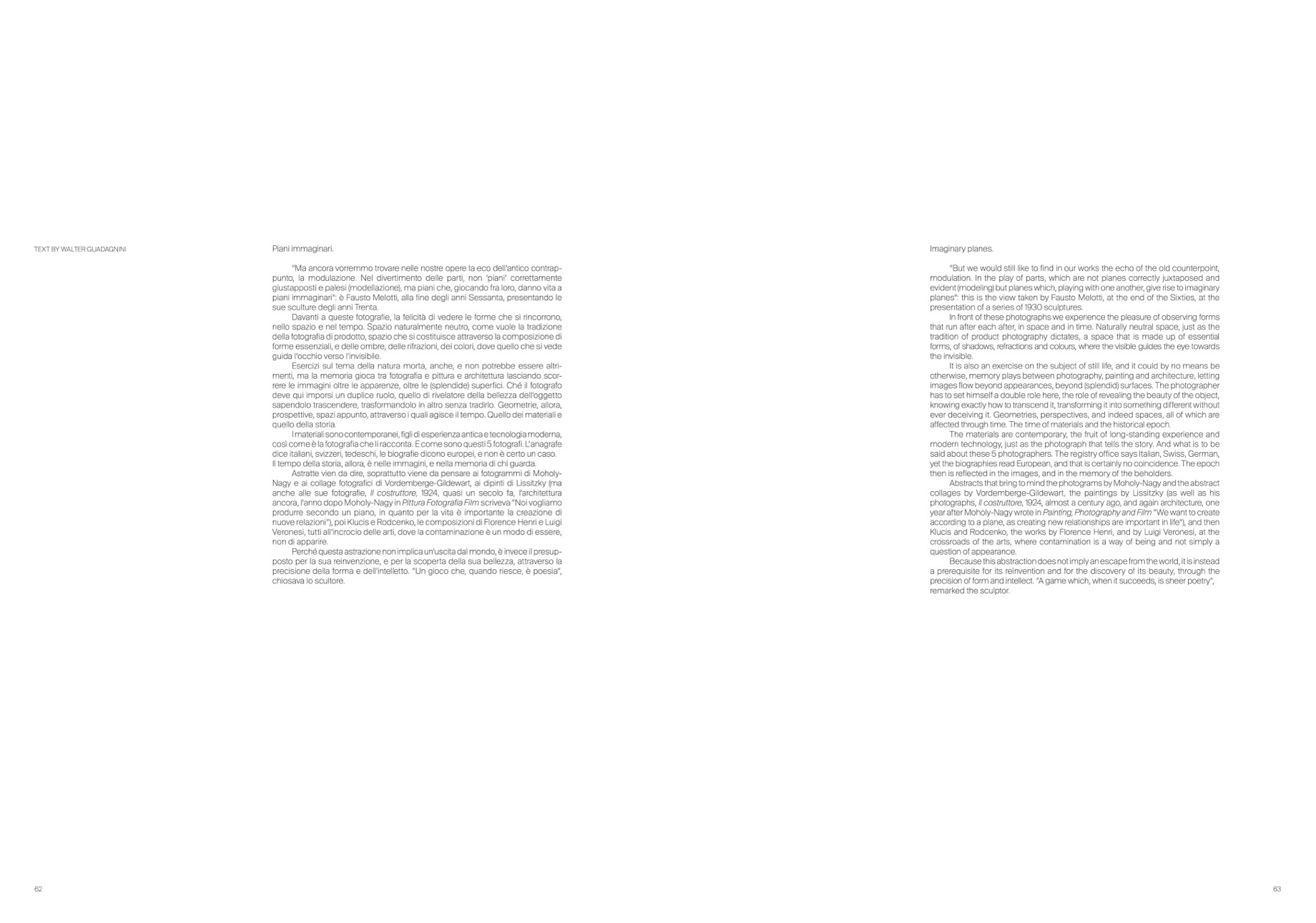
TEXT BY WALTER GUADAGNINI
Piani immaginari.
“Ma ancora vorremmo trovare nelle nostre opere la eco dell’antico contrap-
punto, la modulazione. Nel divertimento delle parti, non ‘piani’ correttamente
giustapposti e palesi (modellazione), ma piani che, giocando fra loro, danno vita a
piani immaginari”: è Fausto Melotti, alla fine degli anni Sessanta, presentando le
sue sculture degli anni Trenta.
Davanti a queste fotografie, la felicità di vedere le forme che si rincorrono,
nello spazio e nel tempo. Spazio naturalmente neutro, come vuole la tradizione
della fotografia di prodotto, spazio che si costituisce attraverso la composizione di
forme essenziali, e delle ombre, delle rifrazioni, dei colori, dove quello che si vede
guida l’occhio verso l’invisibile.
Esercizi sul tema della natura morta, anche, e non potrebbe essere altri-
menti, ma la memoria gioca tra fotografia e pittura e architettura lasciando scor-
rere le immagini oltre le apparenze, oltre le (splendide) superfici. Ché il fotografo
deve qui imporsi un duplice ruolo, quello di rivelatore della bellezza dell’oggetto
sapendolo trascendere, trasformandolo in altro senza tradirlo. Geometrie, allora,
prospettive, spazi appunto, attraverso i quali agisce il tempo. Quello dei materiali e
quello della storia.
I materiali sono contemporanei, figli di esperienza antica e tecnologia moderna,
così come è la fotografia che li racconta. E come sono questi 5 fotografi. L’anagrafe
dice italiani, svizzeri, tedeschi, le biografie dicono europei, e non è certo un caso.
Il tempo della storia, allora, è nelle immagini, e nella memoria di chi guarda.
Astratte vien da dire, soprattutto viene da pensare ai fotogrammi di Moholy-
Nagy e ai collage fotografici di Vordemberge-Gildewart, ai dipinti di Lissitzky (ma
anche alle sue fotografie, Il costruttore, 1924, quasi un secolo fa, l’architettura
ancora, l’anno dopo Moholy-Nagy in Pittura Fotografia Film scriveva “Noi vogliamo
produrre secondo un piano, in quanto per la vita è importante la creazione di
nuove relazioni”), poi Klucis e Rodcenko, le composizioni di Florence Henri e Luigi
Veronesi, tutti all’incrocio delle arti, dove la contaminazione è un modo di essere,
non di apparire.
Perché questa astrazione non implica un’uscita dal mondo, è invece il presup-
posto per la sua reinvenzione, e per la scoperta della sua bellezza, attraverso la
precisione della forma e dell’intelletto. “Un gioco che, quando riesce, è poesia”,
chiosava lo scultore.
Imaginary planes.
“But we would still like to find in our works the echo of the old counterpoint,
modulation. In the play of parts, which are not planes correctly juxtaposed and
evident (modeling) but planes which, playing with one another, give rise to imaginary
planes”: this is the view taken by Fausto Melotti, at the end of the Sixties, at the
presentation of a series of 1930 sculptures.
In front of these photographs we experience the pleasure of observing forms
that run after each after, in space and in time. Naturally neutral space, just as the
tradition of product photography dictates, a space that is made up of essential
forms, of shadows, refractions and colours, where the visible guides the eye towards
the invisible.
It is also an exercise on the subject of still life, and it could by no means be
otherwise, memory plays between photography, painting and architecture, letting
images flow beyond appearances, beyond (splendid) surfaces. The photographer
has to set himself a double role here, the role of revealing the beauty of the object,
knowing exactly how to transcend it, transforming it into something different without
ever deceiving it. Geometries, perspectives, and indeed spaces, all of which are
affected through time. The time of materials and the historical epoch.
The materials are contemporary, the fruit of long-standing experience and
modern technology, just as the photograph that tells the story. And what is to be
said about these 5 photographers. The registry office says Italian, Swiss, German,
yet the biographies read European, and that is certainly no coincidence. The epoch
then is reflected in the images, and in the memory of the beholders.
Abstracts that bring to mind the photograms by Moholy-Nagy and the abstract
collages by Vordemberge-Gildewart, the paintings by Lissitzky (as well as his
photographs, Il costruttore, 1924, almost a century ago, and again architecture, one
year after Moholy-Nagy wrote in Painting, Photography and Film “We want to create
according to a plane, as creating new relationships are important in life”), and then
Klucis and Rodcenko, the works by Florence Henri, and by Luigi Veronesi, at the
crossroads of the arts, where contamination is a way of being and not simply a
question of appearance.
Because this abstraction does not imply an escape from the world, it is instead
a prerequisite for its reinvention and for the discovery of its beauty, through the
precision of form and intellect. “A game which, when it succeeds, is sheer poetry”,
remarked the sculptor.
62
63

